Meta Brevoort, my 3rd great aunt, was an intrepid Victorian mountaineer who has been an absolute hero to me since I first learned of her achievements. I have written extensively about her niece, my great-grandmother, Lil Coolidge, but have hesitated to write Meta’s story as her exploits have already been documented by others, and she even has her own Wikipedia page.
However, I decided that it was time to reflect on her life after I was contacted by writer and journalist Rosemary J Brown, who was researching a book to celebrate some of the extraordinary women who reached the pinnacles of exploration and are immortalised in destinations named after them. The book is provisionally entitled “Moving Mountains: Trailblazing Women and the Peaks that Bear Their Names” and I will update this page with more details as the work progresses.
Meta was born on 4th November 1825, the fifth child and third daughter of a wealthy and well-connected New York family on her father’s side. Her paternal grandmother and great-grandmother were notorious rebels during the American Revolutionary War, and her grandfather’s stubborn refusal to sell a portion of his farm resulted in the bend in New York’s Broadway that exists today (but that’s for another story).
As a young man, Meta’s father, Henry Brevoort Jnr, travelled extensively across remote areas of North America and Canada from where he wrote passionately about the horrendous treatment of indigenous people by his own countrymen[i]. Henry Jnr also spent over a year travelling around war-torn Europe during the later years of the First French Empire ruled by Napoleon Bonaparte, before returning to America to accept a commission in a volunteer light infantry corps known as the “Iron Greys”[ii] during the Anglo-America War of 1812.
In 1817, Henry, by now a patron of the arts and literature, married Laura Elizabeth Carson. After the birth of six children, including Meta, he decided that his household would benefit from life in Europe, so they relocated for several years to Paris, France. Meta and her sisters attended the fashionable Convent of the Sacred Heart in Paris[iii], while her brothers attended a progressive Swiss boarding school[iv] where pupils of all social classes combined manual labour with studies of literature and science. During their time in Europe, two more children were born to the Brevoorts but, sadly, Meta’s older brother William died whilst away at boarding school aged just 13[v]. Henry, Laura, and their children returned to New York in the mid 1830s, where they resided in a mansion commissioned by Henry and built on a section of his father’s farm on the corner of what became Fifth Avenue.

From their well-appointed modern townhouse, the Brevoorts set the pace for social events of New York’s high society. Henry, once described in the New York press as a “gentleman of great wealth and unlimited leisure”, was one of the key organisers of a grand dinner for English novelist Charles Dickens during his visit to New York in 1842[vi].
Around this time Meta’s mother Laura’s health began to fail, so she and her daughters spent the summer of 1843 at a country retreat in Long Island where they would enjoy fine weather and sea-bathing[vii]. Henry, in a letter to his great friend Washington Irving, described his daughters as having “a true relish for country life and would much rather roam over the green fields of Long Island than mingle with the harlequinade of Broadway”.[viii]
Laura died in 1845 and Henry died three years later, but their children remained in the Brevoort Mansion. The 1850 Federal census lists Meta as living with her elder sister Elisabeth, now married to Frederick Coolidge, along with younger sisters Constance and Edith, younger brother Henry, and a handful of servants[ix].
Around this time, Meta assumed the role of Manager of the ‘Association for the Benefit of Colored Orphans’ (sic)[x], an asylum for destitute African American children[xi] situatied close to her home on Fifth Avenue. Although slavery had been abolished in New York in 1827, the prevailing poverty among ex-slaves and free blacks meant that many families were unable to stay together. The Association was created in 1836 by a coalition of Quakers, Presbyterians, and Abolitionists to assist the children with shelter and education[xii]. Meta may have worked alongside Dr James McCune Smith, the first licensed black medical doctor in the United States, who became the orphanage’s medical director in 1846. The number of children cared for varied between 200 and 800 children at any given time, but fewer than a third were orphans, and once they reached about 12 years of age, many were returned to their parents or placed in positions as farm labourers or domestic servants.

Within a couple of years, Meta had transitioned to the role of Financial Secretary to the ‘House and School of Industry’[xiv] established in 1851 to teach poor women ”plain and fine sewing”. The aim was to encourage those facing difficulties to improve their prospect by acquring a skill rather than turning to vice, crime, or insurrection[xv].
By 1855, Meta had resolved to dedicate her life to social service and had joined the ranks of the ’Sisters of the Holy Communion’[xvi]. In this capacity, she worked as a nurse in a small infirmary and conducted a parish school. The sisterhood was linked to a progressive Episcopal ‘free church’ where pews were not rented or bought, and rich and poor were treated equally allowing them to sit where they wished in the church. The Sisters, including Meta, wore regulation dress but no habits and, instead of vows, they made pledges of service, renewable in three-year terms.
Meta had continued to live with her sister Elisabeth from the time of her marriage, during which time four children were born to Elisabeth and Frederick Coolidge. However, the deaths of two of the Coolidge children, 5-year-old Fred Junior in 1860 and 8-year-old Laura in 1861, may have cast a shadow over their parents’ marriage. No doubt the politics and rhetoric surrounding the advent of the American Civil War would have troubled Meta and her sister deeply, particularly as their mother was from the South and their father from the North.
In the summer of 1863, New York City experienced the Draft Riots, which today remain the largest civil and racially charged urban uprising in American history. Initially, this began as a protest by the city’s Irish community against conscription to fight in the Civil War, but this quickly escalated into a race riot against African Americans who were paid more than the Irish immigrants. The rioters were generally working-class men who resented wealthier men who could afford to either pay a $300 commutation fee or hire a substitute to take their place[xvii], so were spared from the draft. At the time a typical labourer’s wage was somewhere between $1.00 and $2.00 a day.
On the morning of Monday 13th July, a mob of several thousand, including women and children, took to the streets of Manhattan and began smashing windows, burning building, and pulling up cobblestones from the streets. Their trail of destruction took them to the Orphans’ Asylum where they broke into the building and looted food and supplies before setting it on fire. Although over 200 children were led to safety by the staff, at least 120 people were killed and more than 2,000 – mostly African Americans – were injured during the three days of rioting. By the time the military reached the city on the second day of rioting, several public buildings, two Protestant churches, and the Orphans’ Asylum burned to the ground. The homes of various abolitionists or sympathisers, and many black homes had also been destroyed.
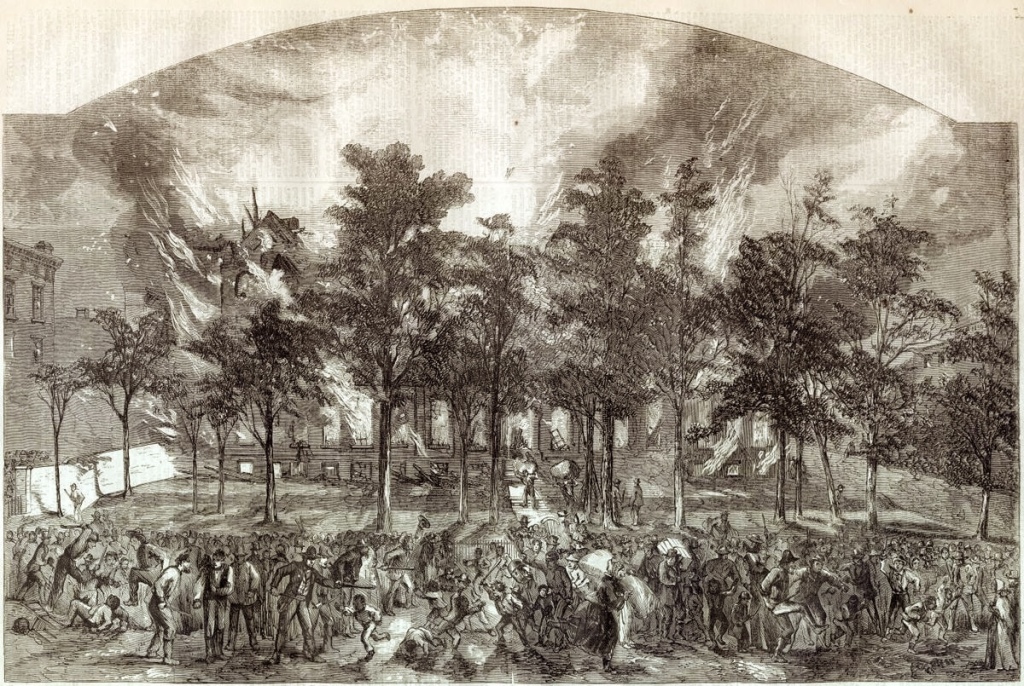
It may have been a combination of the civil unrest and Elisabeth’s failing marriage that prompted the sisters to leave New York for Europe on 16 July 1864 accompanied by Elisabeth’s children 14-year-old William and 7-year-old Lil. None of them would ever return to their homeland.
That autumn, having passed through Paris and nursed young William through typhoid fever, the sisters headed South and settled in Cannes, then a small resort in the South of France, where William would spend several months convalescing[xix]. Ever the adventurer, Meta set out to explore the local countryside and took the opportunity of ascending the Pezou, a minor peak to the North of Cannes. When she reached the top, quite exhilarated, Meta beheld the fantastic panorama below her and began to wonder what could be seen from a higher peak further inland and whether such a venture would be beneficial to young Will…
Initially, like many a typical teenager, Will showed no interest in mountains or any kind of physical exertion. However, Meta was undeterred and persisted in encouraging him by dragging him along on ever more challenging expeditions above the snow line. No doubt thanks to her fortitude, Meta and Will became increasingly intrigued by the new sport of mountaineering, despite – or perhaps because of – Queen Victoria’s desire to ban climbing following the accidental deaths of four climber who fell from the Matterhorn shortly after reaching the summit.
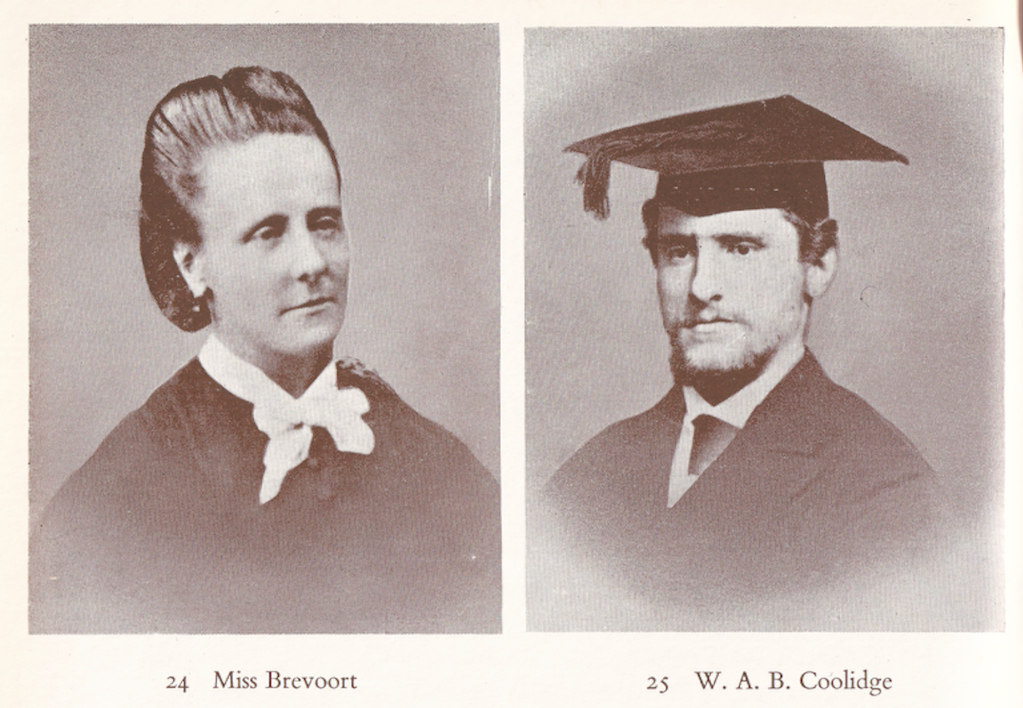
Meta and Will’s shared enthusiasm soon transformed into a passion that would change the course of their lives forever. Together with Tschingel, a small female beagle-type dog given to them by their regular Swiss guide Christian Almers, they became known “the most famous trio in the Alps”[xxi].
Tschingel wore a brown leather collar adorned with silver tags inscribed with the famous peaks and passes she had travelled. Interestingly, Meta always referred to the little dog as ‘he’, even after ‘he’ had given birth to several litters of puppies. In 1875, Tschingel became the first dog to reach the summit of Mont Blanc and, that same year, she was elected as an honorary member of the Alpine Club becoming, as Meta wrote to her sister Elisabeth, ‘the first lady ever admitted into that exclusive body’[xxii]. It would take another 100 years until human females were allowed membership, thereby barring Meta from being accepted.
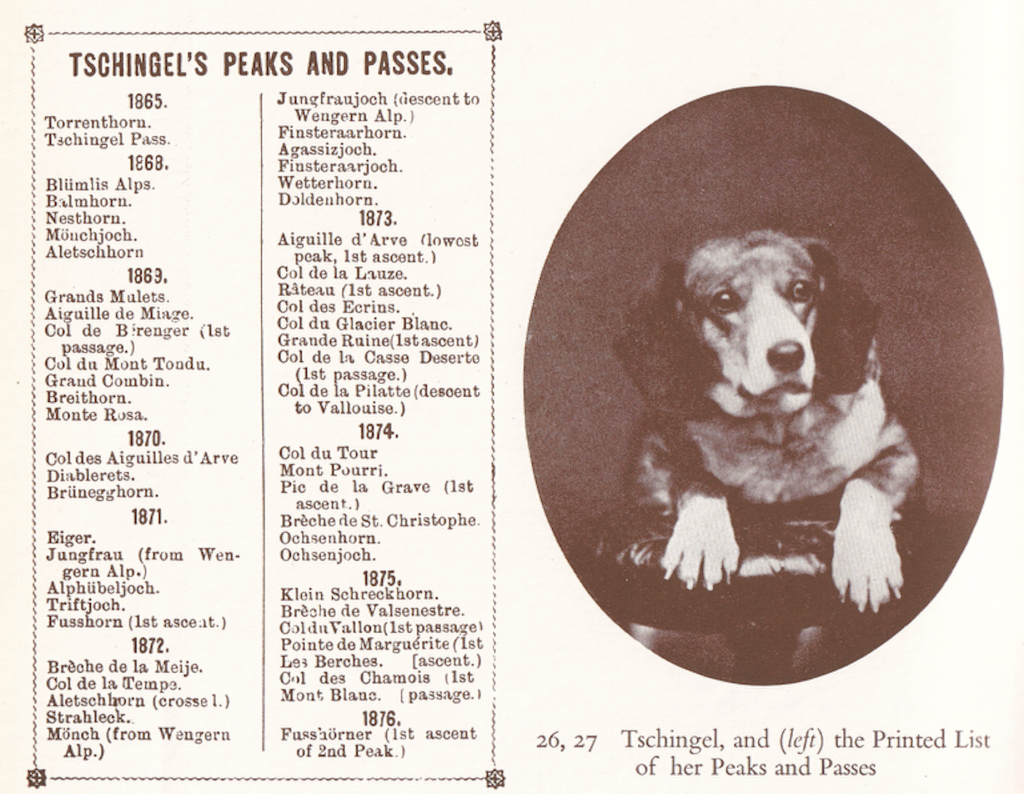
Will would eventually become an internationally respected alpinist, academic, and mountaineering historian, making around 1,750 ascents. He too was honoured with membership of the Alpine Club aged just twenty, and would later make one of the first systematic explorations of the Swiss, French, and Italian Alps[xxiv]. Better known by his full name of William Augustus Brevoort Coolidge, or the Rev. W.A.B. Coolidge, he was recognised as ‘the most learned expert in Alpine topography that has ever lived’[xxv].
Despite only beginning to climb in her 40th year, Meta’s achievements during the next decade were astonishing. She scaled forty-four Alpine peaks, reaching sixteen summits over 4,000 feet, and crossed thirty-five high mountain passes. The list of her accomplishments is extensive, including several firsts by any sex as well as firsts by a woman, with too many to detail here. However, one of her most memorable moments occurred on a bitterly cold yet sunny October morning in 1865. Accompanied by her friend Mme Denise Sylvain-Couttet and two guides, Meta reached the summit of Mont Blanc, the highest peak in Western Europe. At Meta’s suggestion they celebrated by toasting the mountain with a bottle of champagne (basic equipment when mountaineering), dancing a quadrille, and singing ‘La Marseillaise’ at the top of their voices[xxvi]. This French Revolutionary anthem was banned in France at the time, yet Meta, a passionate republican committed to the ideals of liberty and free speech, embraced it even during the Second Empire under the regime of Napoleon III.

During her early climbs, Meta found her mobility was limited by her heavy woollen outer garments, hooped skirts, and heavily boned corsets typical of the clothing of the day. Always experimenting, she began by removing her crinoline hoop as soon as they’d left the regular paths, replacing it at the end of the day. Dealing with her long skirts proved more challenging. She attempted to sew brass rings threaded with tape to haul it up like an Austrian festoon blind, but this was not a success. In a letter to her sister Elisabeth, she lamented, ‘My dress plan too has failed, and descending snow slopes the snow enters between the rings and stuffs up the hem and makes me heavy and wet. I have had to baste up both dress and skirt’[xxvii]. Ultimately, Meta became the first female mountaineer to wear trousers, discreetly hidden beneath her skirt until she had reached a point away from scandalised eyes when she could remove the skirt and leave it behind concealed beneath a rock, ready to retrieve upon her return. Once, Meta forgot to put her skirt back on for the descent and had to waste a whole day searching for it[xxviii].
Meta’s climbing history is remarkable for anyone of the time. In 1869, she attempted to become the first female to climb the Matterhorn. Approaching from the Italian side, she reached an altitude of just under 4,000 metres before being forced to turn back due to severe weather conditions. Two years later, Meta planned to try again, setting out for Zermatt, Switzerland. However, her English rival Lucy Walker was already in Zermatt and, upon receiving news of Meta’s plans, quickly organised her own group and made the summit a few days before Meta’s arrival. This achievement made Lucy the most famous female mountaineer of the era.
The first and only time that Meta and Lucy met was in Zermatt shortly after Lucy’s success on the Matterhorn. Contemporary sources indicate that congratulations were exchanged, and one can imagine a very ladylike encounter, although Meta must have been bitterly disappointed.
Meta succeeding in publishing only one article, ‘A Day and a Night on the Bietschhorn’, which she submitted to the Alpine Club under her nephew’s name, fully aware it could not have been accepted under a woman’s name. Published in the Alpine Journal in 1872 it remains a fascinating, if somewhat melodramatic, read even today.
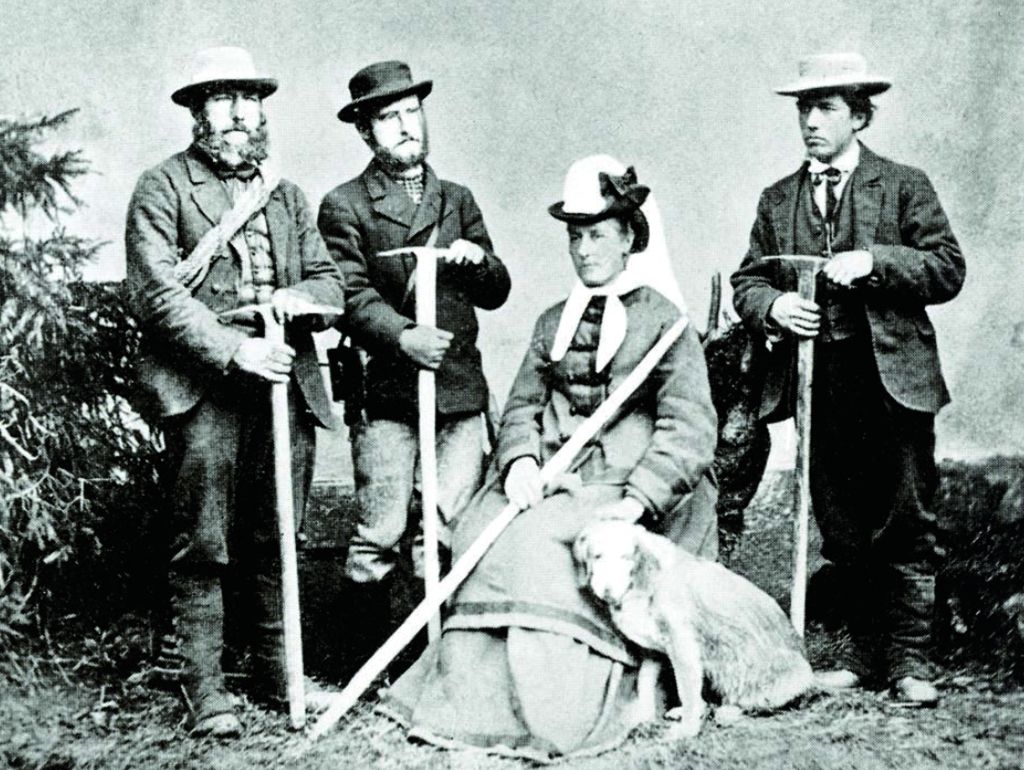
In 1875, following her sister Elisabeth’s sudden death in Oxford, Meta and her niece Lil took a house in Dorking, Surrey. However, in December 1876, Meta contracted rheumatic fever and died at her home in Dorking, Surrey, aged just 51. She was buried in a very pretty cemetery in Oxford beside her older sister Elisabeth.

Tschingel lived for another three years and died peacefully in her sleep in front of the kitchen fire at the house in Dorking in 1879. That same year, ‘La Marseillaise’, the rousing battle song Meta had sung with great gusto atop Mont Blanc, was adopted as France’s national anthem, and remains such to this day.
I have no doubt that Meta would be quietly delighted to know that two peaks in the Dauphine Alps in south-eastern France, Pointe Brevoort and Point Marguerite, have since been named in her honour, and in 2019 a brass plaque bearing her name was added to the ‘Walk of Climb’ along the Bahnhofstrasse in the centre of Zermatt, Switzerland, commemorating the first climbers of the iconic Matterhorn which straddles the border between Switzerland and Italy.
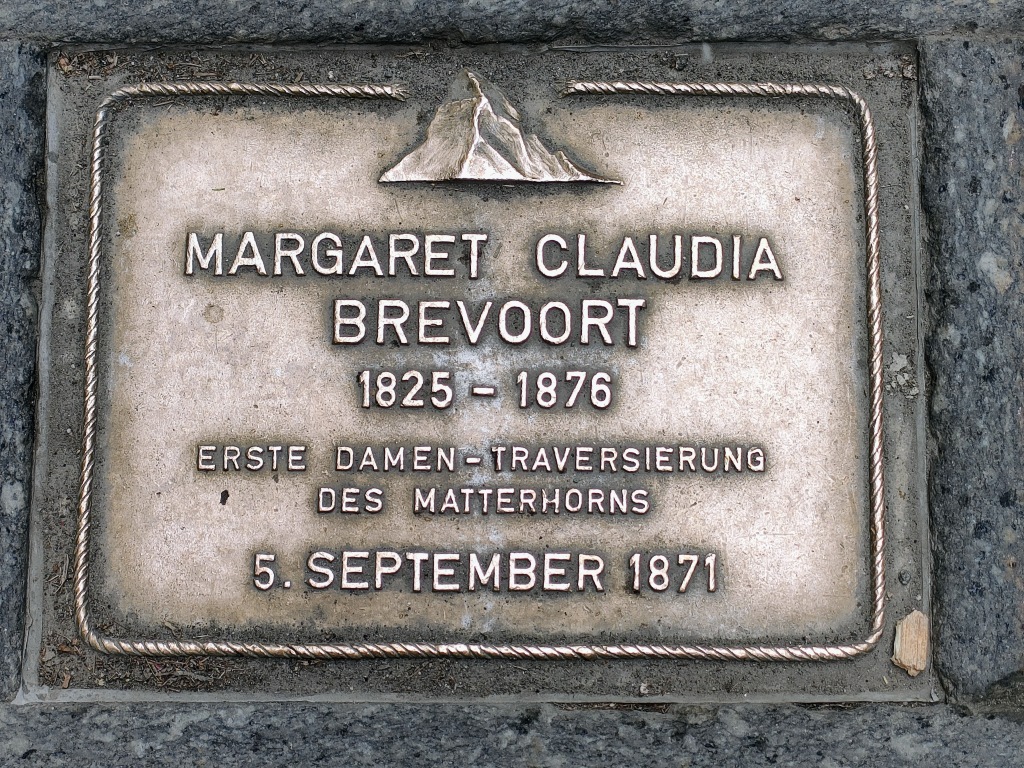
My own mother was named Elisabeth Neville after her great-grandmother, Meta’s sister, and I grew up hearing tales of WAB Coolidge and Tschingel’s exploits. Tschingel’s pretty collar used to hang from a small hook in a dark oak bureau in my grandmother’s house but, sadly the collar, together with an album of photographs, was lost after my grandmother’s death in 1972.
Remarkably, no-one in my family ever spoke of Meta or her achievements, but perhaps that was a reflection upon attitudes to women in the 1960s: ’not the done thing for a lady’ and all that. Thankfully, attitudes have now changed and we can celebrate her remarkable accomplishments and contributions to mountaineering history.
[i] Letters of Henry Brevoort to Washington Irving, together with other unpublished Brevoort papers by Henry Brevoort via https://archive.org/details/lettersofhenrybr00bre last accessed 20 Mar 2024
[ii] Ibid
[iii] An Eccentric in the Alps the Story of the Rev. W.A.B. Coolidge the Great Victorian Mountaineer by Ronald W. Clark | Published by Museum Press, 1959
[iv] Letters of Henry Brevoort to Washington Irving, together with other unpublished Brevoort papers by Henry Brevoort via https://archive.org/details/lettersofhenrybr00bre last accessed 20 Mar 2024
[v] The Todd Genealogy by Richard Henry Greene published 1867 page 24
[vi] The Sun, London, England – 25 Apr 1842 via findmypast.co.uk last accessed 20 Mar 2024
[vii] Letters of Henry Brevoort to Washington Irving, together with other unpublished Brevoort papers by Henry Brevoort via https://archive.org/details/lettersofhenrybr00bre last accessed 20 Mar 2024
[viii] Ibid
[ix] United States Federal Census 1850; New York Ward 12, New York, New York; Roll: M432_548; Page: 38B via ancestry.com
[x] Manual of the corporation of the city of New York 1850 and 1851 via archive.org last accessed 20 Mar 2024
[xi] The Colored Orphans Asylum of New York (1836-1946) via www.blackpast.org last accessed 20 Mar 2024
[xii] Ibid
[xiii] Public domain image via www.blackpast.org last accessed 20 Mar 2024
[xiv] Manual of the corporation of the city of New York 1852 via archive.org last accessed 20 Mar 2024
[xv] New York Times 09 Sep 1987
[xvi] New York State Census 1855; New York City, Ward 18; via ancestry.com
[xvii] The draft in the Civil War via www.u-s-history.com last accessed 20 Mar 2024
[xviii] Harper’s Weekly 1 Aug 1863, Public domain, via Wikimedia Commons last accessed 20 Mar 2024
[xix] An Eccentric in the Alps the Story of the Rev. W.A.B. Coolidge the Great Victorian Mountaineer by Ronald W. Clark | Published by Museum Press, 1959
[xx] Image from The Victorian Mountaineers by Ronald Clark, published by BT Batsford, 1953
[xxi] An Eccentric in the Alps the Story of the Rev. W.A.B. Coolidge the Great Victorian Mountaineer by Ronald W. Clark | Published by Museum Press, 1959
[xxii] Ibid
[xxiii] Image from The Victorian Mountaineers by Ronald Clark, published by BT Batsford, 1953
[xxiv] Biography of William Augustus Brevoort Coolidge via britannica.com last accessed 20 Mar 2024
[xxv] The Alps from End to End by Sir William Martin Conway, published 1895 via archive.org last accessed 20 Mar 2024
[xxvi] ‘Les Femmes Alpinistes: Miss Brevoort’ by Mary Paillon published in the Annuaire de Club Alpin Francais 26 (1899)
[xxvii] An Eccentric in the Alps the Story of the Rev. W.A.B. Coolidge the Great Victorian Mountaineer by Ronald W. Clark | Published by Museum Press, 1959
[xxviii] The Blessings of a Good Thick Skirt by Mary Russell | published by Collins, 1986
[xxix] Unknown author, image in the Public Domain via Wikimedia Commons last accessed 20 Mar 2024